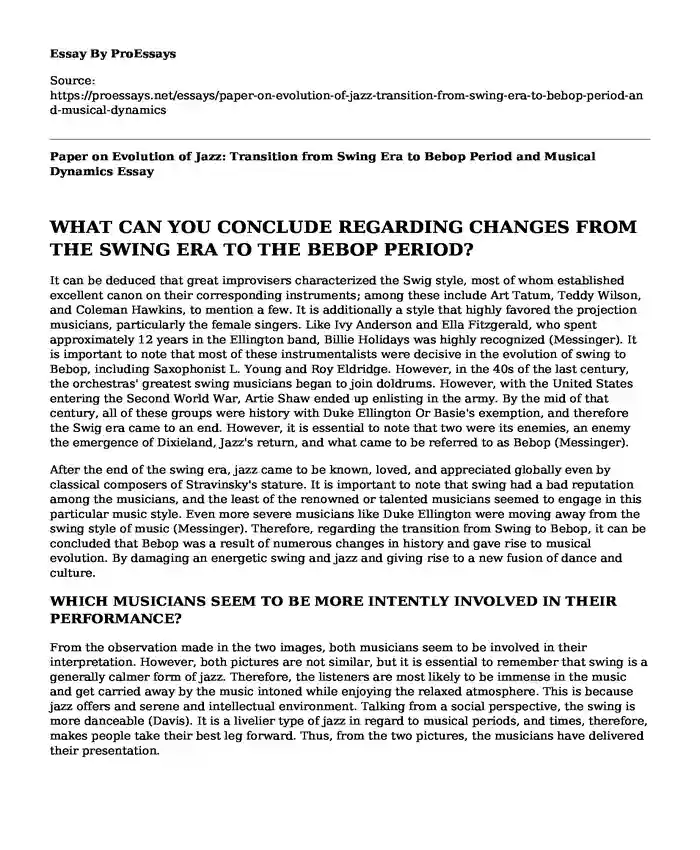WHAT CAN YOU CONCLUDE REGARDING CHANGES FROM THE SWING ERA TO THE BEBOP PERIOD?
It can be deduced that great improvisers characterized the Swig style, most of whom established excellent canon on their corresponding instruments; among these include Art Tatum, Teddy Wilson, and Coleman Hawkins, to mention a few. It is additionally a style that highly favored the projection musicians, particularly the female singers. Like Ivy Anderson and Ella Fitzgerald, who spent approximately 12 years in the Ellington band, Billie Holidays was highly recognized (Messinger). It is important to note that most of these instrumentalists were decisive in the evolution of swing to Bebop, including Saxophonist L. Young and Roy Eldridge. However, in the 40s of the last century, the orchestras' greatest swing musicians began to join doldrums. However, with the United States entering the Second World War, Artie Shaw ended up enlisting in the army. By the mid of that century, all of these groups were history with Duke Ellington Or Basie's exemption, and therefore the Swig era came to an end. However, it is essential to note that two were its enemies, an enemy the emergence of Dixieland, Jazz's return, and what came to be referred to as Bebop (Messinger).
After the end of the swing era, jazz came to be known, loved, and appreciated globally even by classical composers of Stravinsky's stature. It is important to note that swing had a bad reputation among the musicians, and the least of the renowned or talented musicians seemed to engage in this particular music style. Even more severe musicians like Duke Ellington were moving away from the swing style of music (Messinger). Therefore, regarding the transition from Swing to Bebop, it can be concluded that Bebop was a result of numerous changes in history and gave rise to musical evolution. By damaging an energetic swing and jazz and giving rise to a new fusion of dance and culture.
WHICH MUSICIANS SEEM TO BE MORE INTENTLY INVOLVED IN THEIR PERFORMANCE?
From the observation made in the two images, both musicians seem to be involved in their interpretation. However, both pictures are not similar, but it is essential to remember that swing is a generally calmer form of jazz. Therefore, the listeners are most likely to be immense in the music and get carried away by the music intoned while enjoying the relaxed atmosphere. This is because jazz offers and serene and intellectual environment. Talking from a social perspective, the swing is more danceable (Davis). It is a livelier type of jazz in regard to musical periods, and times, therefore, makes people take their best leg forward. Thus, from the two pictures, the musicians have delivered their presentation.
WHICH AUDIENCE SEEMS TO BE GETTING THE MOST ENJOYMENT FROM THE MUSIC.
From observation and at first glance, one might be compelled to say that the swing photograph audiences are having a better time, and this is because it is livelier. However, it must be noted that both Bebop and swing are subgenres of jazz and such that have their differences (Davis). Swing is faster, and Bebop is the prominent role soloist, and therefore it captivates its audiences with the way instruments are executed (Andrews). But only in context, both of the audiences are having a good time.
WHY DO YOU SUPPOSE THE SIZE OF THE MUSICAL ENSEMBLE CHANGED FROM THE SWING ERA TO THE BEBOP PERIOD?
The marching bands significantly reduced in size and therefore gave way to the New Orleans form ensemble with three melodic tools, trumpet or cornet, trombone, and rhythm sections such as tuba, drums, banjo as well and piano. In this type of grouping, an instrument had a role in music but did not affirm its independence.
BASE YOUR RESPONSES ON YOUR READINGS, AND WHAT YOU OBSERVE IN THESE PHOTOGRAPHS.
It can be noted that the swing style has reached a high degree of commerciality, and this will continue, unlike the New Orleans style in which it is bound to become a mass spectacle. The history of jazz developed in line with the evolution of its recording techniques, allowing for different recording techniques and its presentation.
Works Cited
Davis, Miles. Swing & Bebop: The Transformation of Jazz. 10 Feb. 2015, aa4443a.wordpress.com/2015/02/09/swing-bebop-the-transformation-of-jazz/.
Messinger, Colin M. How Bebop Came to Be: The Early History of Modern Jazz. 2013, cupola.gettysburg.edu/cgi/viewcontent.cgi?article=1263&context=student_scholarship.
Andrews, John. What Bebop Meant to Jazz History. 22 May 1998, www.wsws.org/en/articles/1998/05/bop-m22.html.
Cite this page
Paper on Evolution of Jazz: Transition from Swing Era to Bebop Period and Musical Dynamics. (2023, Dec 31). Retrieved from https://proessays.net/essays/paper-on-evolution-of-jazz-transition-from-swing-era-to-bebop-period-and-musical-dynamics
If you are the original author of this essay and no longer wish to have it published on the ProEssays website, please click below to request its removal:
- Music Psychology Essay Example
- Personality Disorder of Frankie in Frankie and Alice Movie Analysis
- Jane Krakowski as Jacqueline White in Unbreakable Kimmy Schmidt Essay
- Essay Sample on Understanding Hip-Hop: A Revolution Beyond Music
- Black Hip Hop: Addressing Inequality Through Music - Essay Sample
- Essay Example on Renaissance Era: Music & Universe Changes (1450-1600)
- Essay Example on Symbolism in Literature: Technology's Role in Culture & Identity







